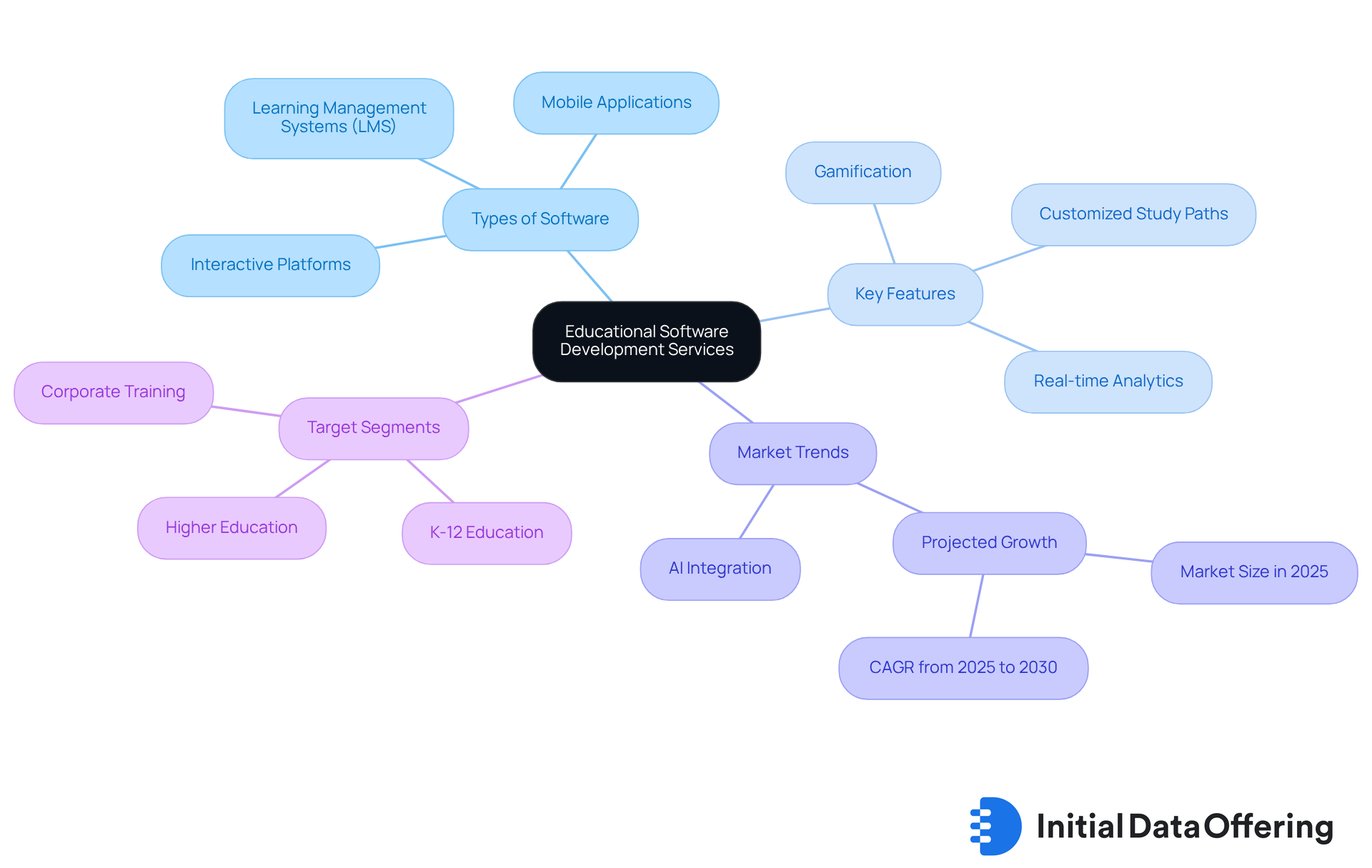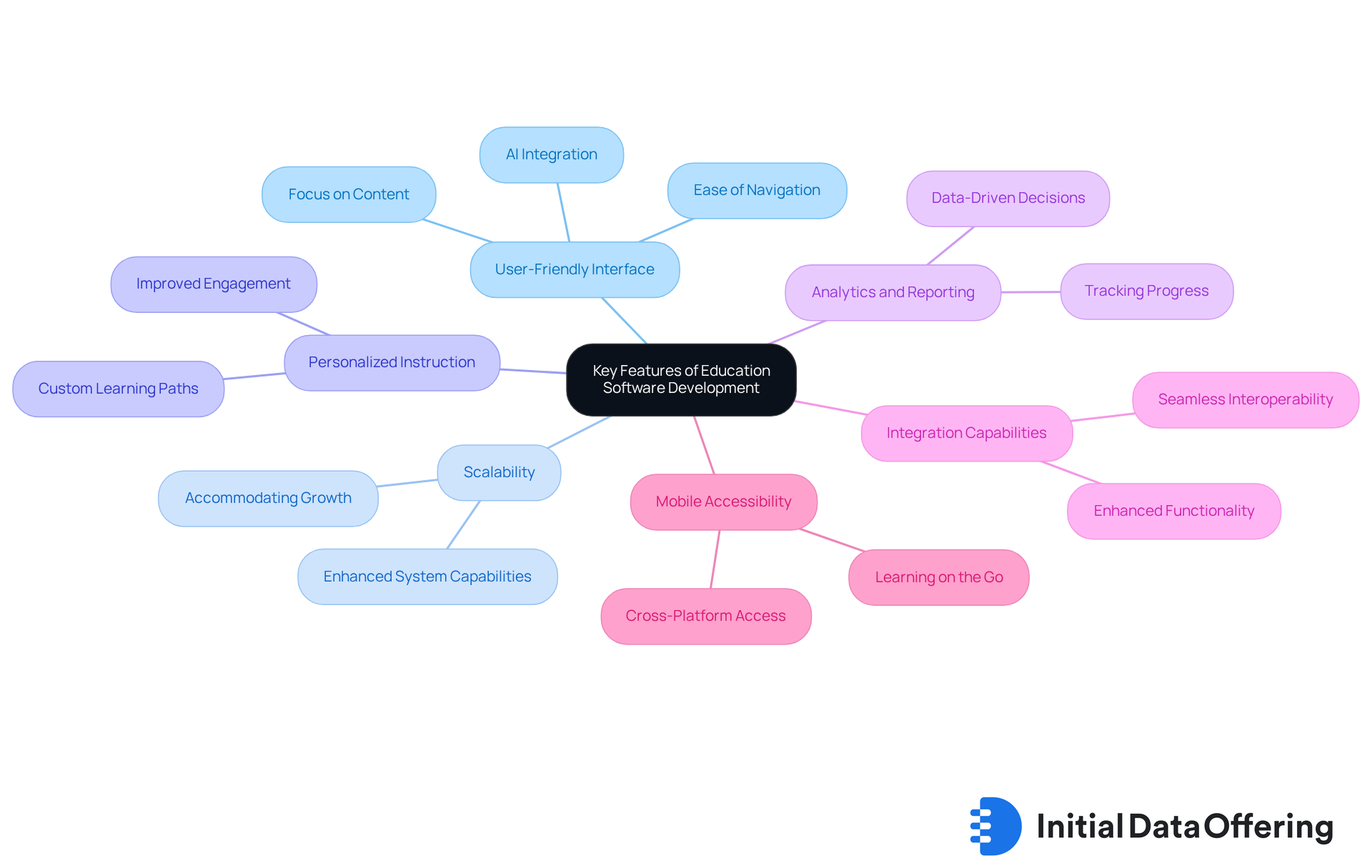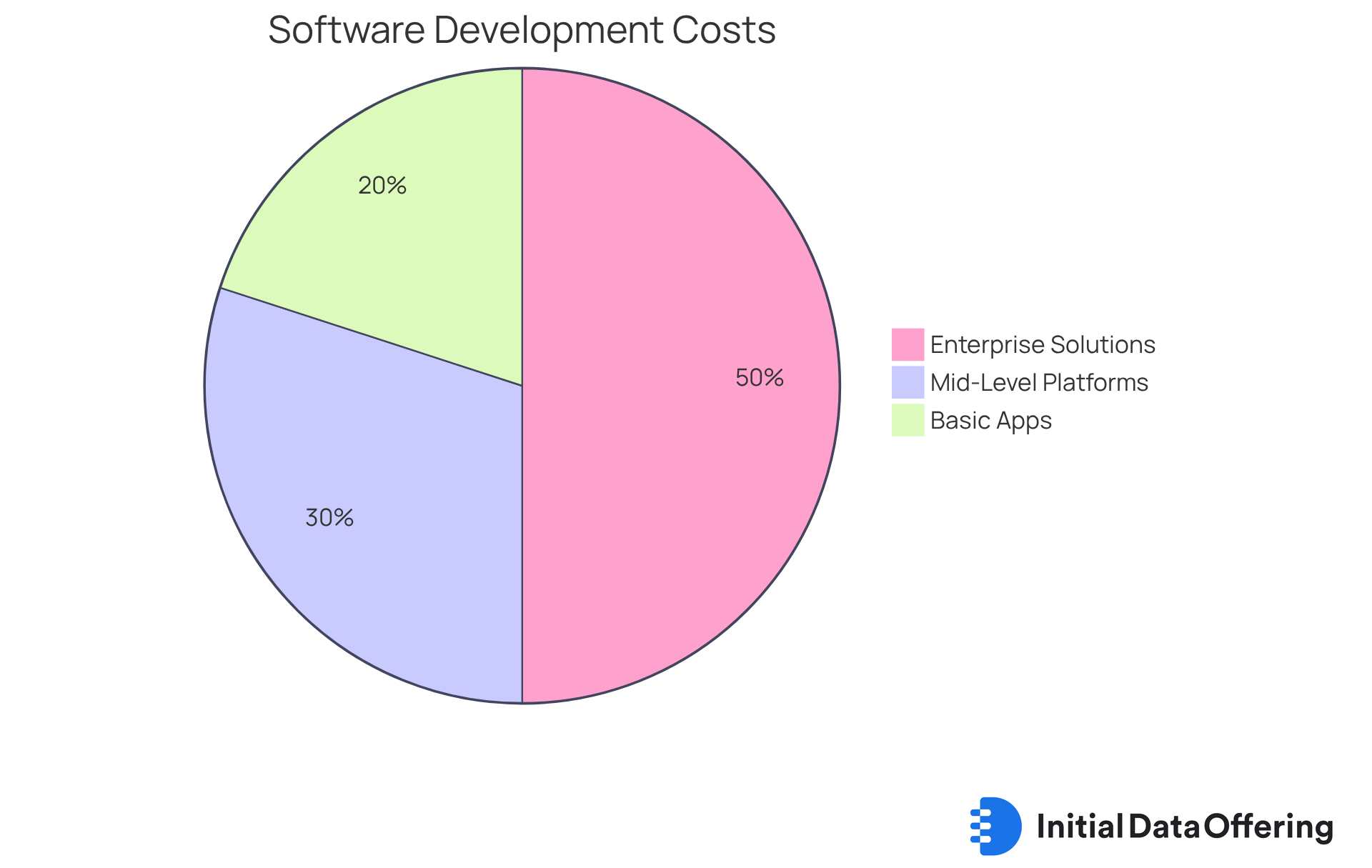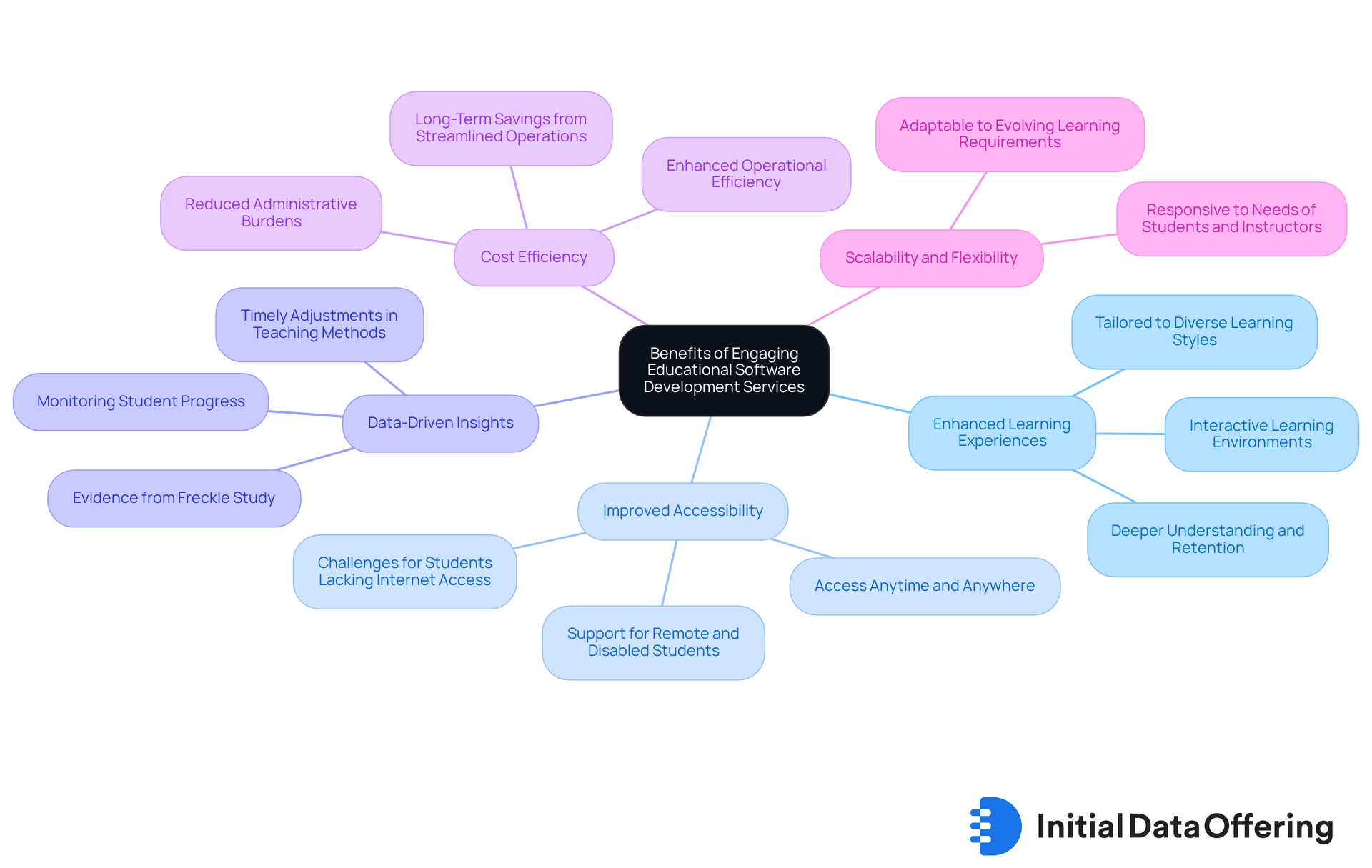Compare Educational Software Development Services: Features, Costs, Benefits

Compare Educational Software Development Services: Features, Costs, Benefits
Overview
This article provides a comprehensive comparison of educational software development services by examining their key features, costs, and benefits, thereby underscoring their significance in contemporary education. It begins by detailing various features, such as:
- User-friendly interfaces
- Robust analytics
These features enhance the overall usability of the software. Next, it outlines the cost ranges associated with different types of software, offering a clear perspective on financial considerations. Furthermore, the article discusses the substantial advantages these services offer, including:
- Enhanced learning experiences
- Improved accessibility for diverse learners
By understanding these elements, educators and institutions can make informed decisions that align with their educational goals.
Introduction
The landscape of education is rapidly evolving, driven by the increasing integration of technology in teaching and learning. As educational institutions strive to enhance their instructional methods and administrative processes, the demand for educational software development services has surged. This article delves into the essential features, advantages, and benefits associated with these services, offering insights into how they can transform the educational experience. However, with a diverse market and varying price points, how can institutions navigate the complexities of selecting the right software development partner to meet their unique needs?
Overview of Educational Software Development Services
Education software development services play a crucial role in shaping the future of education by developing digital tools that enhance instruction, teaching, and administrative processes. These services encompass the creation of Learning Management Systems (LMS), mobile applications, and interactive instructional platforms. They are designed to improve user engagement through features such as gamification, customized study paths, and real-time analytics. As educational institutions increasingly recognize the importance of digital tools, the demand for education software development services is on the rise, particularly in 2025, when the global education technology market is projected to reach USD 348.41 billion, expanding at a compound annual growth rate (CAGR) of 13.3% from 2025 to 2030.
Expert insights underscore the significance of learning resources in modern educational environments. With 60% of instructors already employing AI in their classrooms, the integration of advanced technologies is revolutionizing teaching practices. Successful initiatives, such as the incorporation of AI-driven features in platforms like Google Classroom, illustrate the effectiveness of these tools in enhancing student engagement and outcomes.
The market for education software development services is diverse, with providers targeting various segments, ranging from K-12 solutions to higher education systems. This diversity allows institutions to select tailored solutions that meet their specific needs, ultimately improving the educational experience and fostering better outcomes. As the education landscape continues to evolve, the relevance of education software development services will only increase, making them essential for institutions striving to modernize their teaching methodologies and enhance student success.

Key Features of Leading Education Software Development Companies
Prominent instructional program development firms typically offer education software development services that enhance the academic experience. Key features include:
-
User-Friendly Interface: A well-designed interface ensures ease of navigation for both educators and students, promoting engagement. Experts emphasize that a user-friendly interface is crucial for effective learning environments in education software development services, as it allows users to focus on content rather than struggling with technology. Lindsey Seril points out that '60% of teachers have integrated AI into their regular teaching practices,' underscoring the increasing significance of intuitive design in learning tools.
-
Scalability: As academic institutions expand, their application needs often grow. Scalable solutions provided by education software development services enable organizations to enhance their system capabilities seamlessly, accommodating increased user loads and additional functionalities without compromising performance. The global education technology market, which includes education software development services, is projected to reach USD 348.41 billion by 2030, highlighting the necessity for scalable solutions.
-
Personalized Instruction: Customizing instructional content to unique styles and paces has been shown to improve student outcomes. Successful implementations of personalized learning tools through education software development services demonstrate that adapting to the unique needs of learners fosters greater engagement and retention. Statistics indicate that 'AI enhances completion rates by 70% in learning environments,' reinforcing the value of personalized approaches.
-
Analytics and Reporting: The education software development services we offer include robust analytics tools that provide insights into student performance and engagement levels, empowering educators to make data-driven decisions. This capability is essential for identifying areas for improvement and optimizing instructional strategies using education software development services. The detailed insights provided have enabled educators to track learner progress and fine-tune training strategies for optimal results.
-
Integration Capabilities: Effective education software development services must integrate seamlessly with existing systems and third-party applications. This interoperability enhances functionality and ensures a cohesive user experience across platforms. Case studies, such as those involving NextGen Healthcare's customizable templates, illustrate how integration can enhance operational efficiency.
-
Mobile Accessibility: With the growing dependence on mobile devices for learning, ensuring that resources are accessible on various platforms is essential. Education software development services provide mobile-friendly solutions that cater to the needs of modern learners, allowing them to engage with content anytime and anywhere.
These features not only enhance the learning experience but also streamline administrative tasks, making them essential for institutions aiming to adopt new technologies.

Cost Analysis of Educational Software Development Services
The expense of education software development services can vary significantly based on several factors, including the complexity of the project, the technology stack employed, and the geographical location of the development team. Understanding these cost dynamics is essential for organizations aiming to make informed decisions regarding their technology investments.
On average, development costs can be categorized as follows:
- Basic Educational Apps: Ranging from $20,000 to $50,000, these simple applications feature limited functionalities, making them suitable for straightforward educational needs.
- Mid-Level Platforms: Costs for more intricate solutions, which incorporate features like gamification and analytics, typically fall between $50,000 and $150,000. These platforms provide enhanced user engagement and data insights.
- Enterprise Solutions: Comprehensive systems designed for large institutions often exceed $150,000, reaching up to $500,000 or more. These solutions cater to extensive organizational requirements, ensuring scalability and robust functionality.
Additionally, ongoing maintenance and updates contribute to the overall expense, generally amounting to 15% to 20% of the initial creation cost each year. This ongoing investment is crucial for keeping educational software up-to-date and effective. By comprehending these cost structures, organizations can better navigate their technology investments and align them with their educational objectives using education software development services.

Benefits of Engaging Educational Software Development Services
Engaging education software development services offer numerous benefits that greatly enhance the educational landscape.
-
Enhanced Learning Experiences: Custom software solutions foster interactive and engaging learning environments tailored to diverse learning styles. This approach promotes a deeper understanding and retention of knowledge, ultimately enriching the educational experience for students.
-
Improved Accessibility: Digital platforms dismantle geographical barriers, granting access to learning resources anytime and anywhere. This is particularly vital for students in remote regions or those with disabilities, ensuring fair educational opportunities. However, it is important to acknowledge that barriers still exist for students lacking home internet access, which can hinder their participation and involvement in learning activities.
-
Data-Driven Insights: Advanced analytics tools empower educators to monitor student progress effectively. This capability allows for timely adjustments in teaching methods, which is associated with enhanced learning results. A study involving over 420,000 K-12 students using Freckle indicated significant growth in reading and math skills among those employing customized learning tools, underscoring the value of data-driven approaches.
-
Cost Efficiency: Although the initial investment in custom applications may be considerable, the long-term savings from streamlined operations and reduced administrative burdens can be substantial. Schools that adopt comprehensive digital solutions often report enhanced operational efficiency and resource allocation, demonstrating the financial benefits of such investments.
-
Scalability and Flexibility: As learning requirements evolve, applications can be easily adjusted and expanded to meet shifting demands. This adaptability ensures that learning institutions remain relevant and responsive to the needs of their students and instructors.
These benefits highlight the critical importance of investing in high-quality education software development services, which can profoundly enhance both teaching and learning experiences.

Conclusion
The landscape of educational software development services plays a pivotal role in modernizing educational practices and enhancing student engagement. As institutions increasingly recognize the significance of digital tools, the demand for tailored educational solutions continues to rise, underscoring the necessity for effective software that addresses diverse educational needs.
Key features such as:
- User-friendly interfaces
- Scalability
- Personalized instruction
- Robust analytics
- Integration capabilities
- Mobile accessibility
are essential in shaping effective educational experiences. These attributes not only facilitate enhanced learning but also empower institutions to tailor their offerings to meet specific student requirements. Moreover, a comprehensive understanding of cost structures—from basic applications to comprehensive enterprise solutions—enables organizations to make informed decisions that align with their educational objectives. The benefits of engaging these services extend beyond immediate improvements in learning; they pave the way for enhanced accessibility, data-driven insights, and long-term cost efficiency.
Investing in high-quality educational software development services is not merely a trend; it is a strategic initiative that can significantly transform educational outcomes. As the education technology market continues to grow, embracing innovative software solutions will be crucial for institutions striving to provide equitable, engaging, and effective learning environments. The future of education hinges on these advancements, prompting stakeholders to prioritize digital transformation in their educational strategies. How can your institution leverage these insights to enhance learning experiences?
Frequently Asked Questions
What are educational software development services?
Educational software development services involve creating digital tools that enhance instruction, teaching, and administrative processes, including Learning Management Systems (LMS), mobile applications, and interactive instructional platforms.
What features do educational software development services typically include?
These services often include features such as gamification, customized study paths, and real-time analytics to improve user engagement.
Why is there a growing demand for education software development services?
The demand is increasing as educational institutions recognize the importance of digital tools, with the global education technology market projected to reach USD 348.41 billion by 2025, expanding at a CAGR of 13.3% from 2025 to 2030.
How is AI being integrated into education software?
About 60% of instructors are already using AI in classrooms, which is revolutionizing teaching practices. Successful initiatives, such as AI-driven features in platforms like Google Classroom, demonstrate the effectiveness of these tools in enhancing student engagement and outcomes.
What segments do education software development service providers target?
Providers target a diverse range of segments, including K-12 solutions and higher education systems, allowing institutions to select tailored solutions that meet their specific needs.
What is the significance of education software development services for educational institutions?
These services are essential for institutions aiming to modernize their teaching methodologies and improve student success, as the relevance of such services continues to grow in the evolving education landscape.